공지사항
-
- '노란봉투'캠페인/국제연대..
- no chr.!
5112개의 게시물을 찾았습니다.
Arrest Warrants for KCTU Leaders (K. Herald, 7.24)
Police (today) sought arrest warrants for three top officials of the nation's biggest labor group on charges of orchestrating illegal demonstrations and strikes against U.S. beef imports, and obstructing work last year at branches of a local retailer.
The officials are Lee Suk-haeng, president of the Korea Confederation of Trade Unions, the nation's second-largest umbrella labor group; Senior Vice President Jin Young-ok; and Secretary-General Lee Yong-sik.
"We will combine all cases of lawsuits and complaints against KCTU members regarding the illegal protests in our investigation. Upon the issuance of the writs, we will set up an investigative team dedicated to the matter," a police official told reporters.
They are alleged to have directed KCTU members to go on strike, calling for the renegotiation of the U.S. beef import deal. They are also accused of instructing members illegally demonstrate in front of warehouses in Gyeonggi Province to block the transit of U.S. beef. The beef had been frozen since Oct. 5, when banned backbone fragments were found.
The allegations include that they led unauthorized gatherings against U.S. beef imports, and illegal occupations of public roads during the protests.
Police accuse them of leading or encouraging KCTU members to join the sit-in protests last year at stores of local retail giant E.Land's Homever and New Core stores, located in Sangam-dong and Jamwon-dong in Seoul.
Calling on management to retract a large-scale dismissal of temporary contract workers in July last year, unionized employees participated in illegal sit-ins for about a month.
The labor group roundly berated the government as "quashing democracy by misusing its law enforcement power."
"The Lee Myung-bak dictatorial regime which betrayed the people is trampling democracy by abusing its power after it lost the confidence of the public," the KCTU said in a statement.
"The action (seeking arrest warrants) is an unjust oppression on the rightful exercise of workers' rights to protect public health, and an absolutely political one. We will take it as oppression against our 800,000 members, and collectively and strongly react to it."
A lawmaker of the Democratic Labor Party also railed against the government, calling for the resignation of the National Police Agency Chief Eo Cheong-soo.
"Before seeking arrest warrants, it is more urgent for the government to sack the police chief who ignored the public and led the violent dispersal operations," said Rep. Hong Hee-deok in a statement.
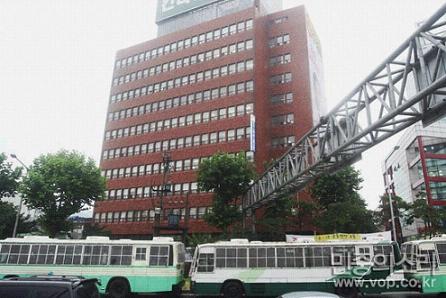
7.24 afternoon: Units of the riot cops in front of KCTU's HQ in Seoul-Yeongdeungpo
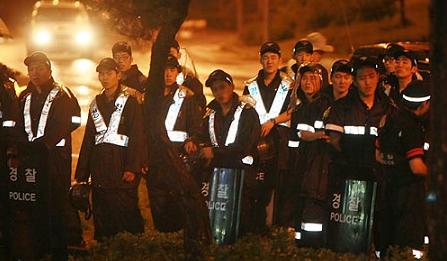
7.24 late evening, near the KCTU HQ: Riot cops ready to arrest the KCTU leaders..

..but until now some hundred supporters are trying to protect them!
Meanwhile the Korea Times reported today that.. "Police plan to award those who contributed to quelling anti-U.S. beef protesters. A total of 385 police officers including riot police will receive awards, said the National Police Agency.." That's real JUSTICE & DEMOCRATIC PROGRESS (aka "liberal democracy", as K. Herald labeled it today in another article) - Made in Korea!!(^^)
Related reports:
☞ 경찰, 민주노총 침탈 움직임 '비상' (KCTU)
☞ 이석행 민주노총 위원장 등 체포영장 발부 (VoP)
☞ 이석행 "촛불 소녀가 왔다는 소식에 목메어" (OhmyNews)
Update (7.25):
KCTU Threatens to Go on Strike (K. Times)
Members of the Korean Confederation of Trade Unions (KCTU) threatened to go on strike, Friday, demanding the government suspend the imports of U.S. beef and abandon its moves to "suppress the union.''
The threat came one day after a court issued an arrest warrant for the union's head and two other leaders. They are under suspicion of organizing illegal strikes calling for the end of U.S. beef imports.
Meanwhile, police said they were in no hurry to arrest them.
"We have no plan to go into the headquarters of the union and arrest them,'' a police officer said. "But if they come out, we will definitely arrest them.''
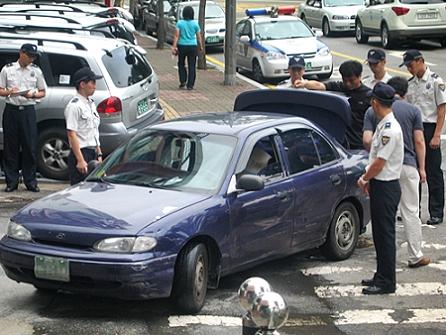
7.25 in front of KCTU HQ. Cops are searching for the union leaders..
BTW.. so there are now two sites in Seoul where anti-gov't activists have to hide because of arrest warrants: 6 activists are hiding Jogye-sa, Seoul's main Buddhist temple in downtown, and the 3 labour union leaders in KCTU's HQ.
Related:
☞ 조계사.민주노총 동시 강제연행 들어가나 (VoP)
☞ 민주노총 사수투쟁…경찰전진배치 (KCTU)
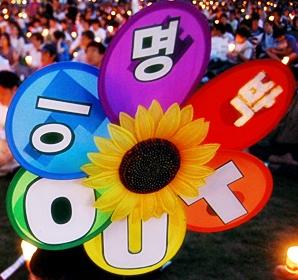
ISRAEL'S WET DREAMS
Today, exactly one week ago, the "prisoner exchange" between Israel and Hizbullah took place.
While Hizbullah claimed it THE MAIN VICTORY for the organization in the last 20 years (*), in Israel - only few hours after the exchange took place - a flood of really extreme strange articles/opinions were published in the (bourgeois) press.
Following you can "enjoy" just one of them, published last Thursday in the daily newspaper Yedioth Ahronoth (**):
Day of infamy
‘Civilized’ is euphemism for weak, helpless; terrorists deserve death penalty
I was a new oleh (Jewish immigrant to Israel) when the PFLP and two Germans hijacked a plane full of Israelis to Entebbe. I remember well those nail-biting days, the moral dilemma of freeing dangerous terrorists for live hostages; the idea that negotiations would just lead to more hijackings. But what other choice did we have? After all, they were in Uganda, so far away.
We found a way.
I will never forget the morning of July 4, 1976, waking up to the news. Our soldiers had gone in, at great personal risk. They had saved almost everyone, and killed the terrorists. We were not helpless victims anymore, the Jews. No, we were clever, and resourceful and courageous. We showed the world how to behave.
We led the way.
I woke up the morning of July 16, 2008 with quite another feeling. Our soldiers, kidnapped on our own land, not across any international border, are brought back to us in caskets after two years of sadistic playfulness with the hearts of their families by Hizbullah terrorists, who led us to believe they were alive. And in exchange for dead bodies, we turn over a despicable baby-killer, Samir Kuntar (***).
Oh, you will hear the boosters of the Israeli government sigh. What can we do? We are civilized and they are not. We care about our soldiers and their families.
No, I’m afraid you do not. If you cared, then you would have a death penalty for people like Kuntar, so that they too can be released in caskets. And if you cared, you would be intelligent enough, seeing our soldiers brought back to us dead, to have put a bullet through Kuntar and then turned him over to his friends.
Civilized is a euphemism for weak and helpless. Civilized is not a moral value, because we all know what Western civilization is capable of. Concentration camps. Civilian round-ups, the gassing of children. All this under the banner of laws and policemen and governments. On the other hand, the moral thing to do to a tried and convicted murderer like Kuntar is to spill his blood, because he has spilled the blood of others. That may not fit in with current civilized niceties, but let no one say it is immoral.
Ashamed to be Israeli today
When it comes to immoral, to release Kuntar to a hero’s welcome and the opportunity to murder others is on the top of the scale.
My government, the Israeli government, arranged this. They let it happen. They oversaw it and implemented it. I am deeply ashamed to be an Israeli today. And I’m not very proud of being a Jew either, if this is how a Jewish country behaves. To lead the world in ever more despicable acts of appeasement is nothing to be proud of. The torch we always carried, the “light unto the nations” has been blown out by the hot-air of our politicians.
If we cared about our soldiers, we would not be showing our enemies that kidnapping and terrorism pay. We would not be setting the stage for the next murderous terrorist raid and hostage standoff. We would be passing laws with a mandatory death penalty for convicted terrorists with blood on their hands, as well as their accomplices. We would be making these laws retroactive.
Then, we would be cutting off all water and electricity to Gaza until Gilad Shalit is released. If that didn’t work, we’d begin executions within one week, increasing the number convicted terrorists facing firing squads with each passing day until Gilad is returned to us safe and sound. And if that didn’t work, we would begin daily bombings of Gaza, with the same number and frequency of attacks that our own city Sderot has suffered over the past three years from the Gazans. Not civilized? Perhaps. But moral. Extremely moral.
My fantasy is that Israelis will rise up and overturn the political system which has left them with the dregs of their nation as leaders - a bunch of self-serving crooks and sycophants who will do anything to stay in office; an electoral system in which a party like Kadima, with its collection of felons and moral imbeciles, who got only 23% of the vote, is allowed to rule us into the ground. We have Mr. Olmert, and Ms. Livni, and Mr. Peres, and Mr. Ramon (a convicted sex offender, who is now in line to take over from Olmert) and many, many others to thank, for creating this day of infamy.
May G-d redeem us from them.
http://www.ynetnews.com/articles/0,7340,L-3569608,00.html
* But there are also others in Lebanon who are not really convinced of Hizbullah's so-called "victory"! Referring to the 2nd Lebanon War (Summer 2006) triggered by the abduction of two IDF soldiers (with the only aim to get "bargain chips" for a prisoner exchange with Israel!), a Lebanese Web site pointed out the following "net losses":
- 1200 civilians dead - 400 of them under 13
- 4400 civilians injured - 700 permanently
- one million displaced from their homes
- 125,000 housing units destroyed or damaged
- 80% of some southern villages destroyed
- 38,850,951 sq.m. contaminated by cluster bombs
- 188 wounded by cluster bombs - 67 of them children
- 20 killed by left-over cluster bombs - five of them children
- $5 billion in economic damages
- $15b. in long-term costs to the economy
- $64 million cleanup of 12,000 tons of oil
- 91 bridges destroyed..
** incl. about 90 (mostly mad) comments by readers! Check it out here!!
*** S. Kuntar's "very special" salute (well, I think that everyone knows the real f... meaning of the notoriously salute..) after his release from Israel, during the "Rally of Victory" in Beirut (7.17), organized by Hizbullah:

Related articles (based on interviews with S. Kuntar):
☞ 'The girl screamed. I don't remember anything else' (Guardian, 7.19)
☞ Allah Willing, I Will Kill More Israelis (documented by MEMRI)

Last Friday the Guardian (UK) published following article about some (possible) new developments in Burma's movement against the dictarorship. While the report is - of course - interesting, in my opinion it's also somehow very concerning, if not even alarming (Why? I'll explain soon!):
Burmese Opposition Ready to Escalate pro-Democracy Fight
Members of Burma's battered and disparate opposition are growing disillusioned with the old methods of the pro-democracy movement and are seeking ways to escalate their armed struggle.
"There is a very real debate among us about how to begin a more sustained armed struggle," an organiser of last September's failed uprising told the Guardian. "We are ready for that kind of action, if we can get the supplies and training that we need."
Speaking from exile in Thailand, Soe Aung, the chief spokesman for the National Council of the Union of Burma (NCUB), an umbrella group representing nearly all facets of Burma's disparate opposition, said he was witnessing a significant shift in the public attitude across Burma.
"After the September uprising and then the terrible cyclone response, the anger is surging. Some are considering violent means … the Burmese people are not that kind of people, there has been a real change."
Soe Aung spoke openly of how covert Western support, primarily from the US state department-funded National Endowment for Democracy (NED) and its subsidiary the International Republican Institute (IRI), had been fundamental to the success of the uprising.
"The US is certainly doing the most for the opposition. There has been real success in training and forming an underground movement through religious organisations and monastic organisations. These provide the best cover inside Burma. The monks can spread their training very effectively."
The NED describes itself as a private organisation but was created by, and remains accountable to, the US Congress. Set up under the Reagan administration in 1983, it has since played a leading role in influencing civil society and electoral processes in countries around the world unfriendly to US interests.
According to Brian Joseph, the man in charge of the group's Burma project, the NED gave $3m (£1.5m) to Burma in 2007. "We would send more, but there is a limit to what you can do in Burma," said Joseph.
Opposition activists both inside and outside Burma largely describe the improvements in political awareness and spread of information as a result of NED-funded projects, but also attribute them to the introduction of the internet to Burma in 2003.
"We could see in September how the advances were utilised. It wasn't just the monks but a massive increase of awareness among Burmese of all types. This was thanks largely due to media organs, the Democratic Voice of Burma, satellite TV, and, of course, the internet," said Soe Aung.
http://www.guardian.co.uk/world/2008/jul/18/burma
Here the final, more detailed version of the article, published in the Guardian, 7.19:
Since last week "demonstrations swept through Korea in response to the Japanese government's decision to claim Dokdo islets (also claimed by South Korea) as part of its territory in its history textbooks" (OhmyNews, 7.18).
While LeeMB called to "all Koreans" to stay in "strong unity against Japan's illegal claim", almost all Koreans (*), involved in any kind of politics, "civil rights", labour activities etc.. followed the demand of the Dear Leader(^^):
"The Dokdo demonstrations brought together Koreans from all ideological stripes and colours. Progressives, conservatives, young and old came together to protest against Japan's actions." (OhmyNews)

While last Wednesday (7.16) protesters, here KCTU/KTU 'activists' (!!), "only"
hurled eggs and tomatoes (WHY not bloody American BSE beef???)
at the Japanese embassy in Seoul..
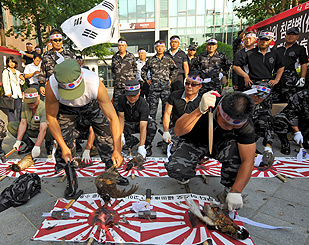
..one day later "protesters in Seoul staged a bloody demonstration
outside the Japanese embassy, slaughtering live pheasants – Japan's
national bird (**) – on the street", according to al-Jazeera (7.18)
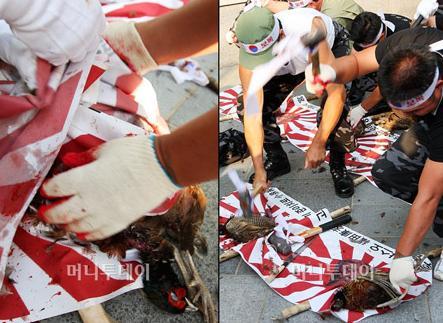
They cut the heads off live pheasants, Japan’s national bird, and dripped the
blood on Japanese flags and on pictures of Prime Minister Yasuo Fukuda and
former Japanese leaders. Some battered birds to death with hammers. Others cut
open bellies and ate the livers, shouting: “Dokdo is our territory!”,
The Standard (HK) reported on the same day.
* Of course not ALL Koreans: A minority of voices called for restraint in this debate. An OhmyNews contributor suggested that Dokdo become an "Island of Korean-Japanese Peace" and have the two countries manage the island and its seas together. According to OhmyNews this article - surprise, surprise!(^^) - incited mostly negative comments among the readers.
** An internet reader from Japan later mentioned following:
There is unintended irony here: The Korean nationalists are killing Common pheasant (Phasianus colchicus),and it’s name in Japan is Kourai-kiji (コウライキジ) meaning “Korean Pheasant”.
The natonal bird of Japan is Green Pheasant (Phasianidae versicolor), a subspecies of Common pheasant only seen in Japan. (^^)
About a very queer development Korea Herald reported last week (7.18):
Educators protest Japan Dokdo claim
Educators are stepping up their efforts to repudiate Japan's latest claim to the Dokdo islets.
The (conservative) Korea Federation of Teachers' Associations sent out letters to 394 teachers' associations in 171 countries, explaining why Japan's sovereignty claim over Dokdo is historically invalid.
"Dokdo has been recognized as a part of Korea historically and by international law, as well. Dokdo is clearly Korean territory, and its people are currently living there," the letter from the association representing over 190,000 teachers reads.
"Among a number of historical documents which prove that Dokdo is a territory of Korea, 'Samguksagi (the Chronicles of Three Kingdoms)' states that, in 512, Shilla, an ancient kingdom of Korea, was comprised of Usanguk, which was a country based on Usan Island (the name of Dokdo at the time)."
The KFTA letter also discussed other evidence, such as the "The complete map of the Joseon Kingdom," which was drawn by the French geographer Danville in 1737; "The map of three adjoining countries," by a Japanese scholar named Hayashi Shihei in 1785, and "The attached map for elementary school geography textbooks," published by the Japanese Government General of Korea in 1934, which was during the Japanese colonial period.
"Besides, it turned out that the imperial Japanese Council of State (Dajokan) confirmed in 1877 that Uleungdo and Dokdo had no connection with Japanese territory," reads the letter signed by KFTA president Lee Won-hee.
"Above all, the KFTA is deeply worried that the Japanese government has tried to take advantage of the invalid assertion of some Japanese, and has written a book for teachers which promotes a distorted history."
The KFTA said that, "as the issue of Dokdo is related to the education and the views about history which the next generation will develop, rather than disputes between two countries, teachers and the organizations responsible for students' education should take the lead in straightening out the matter."
While seeking support from educators around the world, Korean teachers also pledged to thoroughly educate their students about Dokdo to raise their historical awareness. Japan's right-wing textbook publishers and local administrators have continued to make sovereignty claims over Dokdo, based on its seizure of the islands in 1910 when it invaded Korea. (Korea was under Japanese colonial rule from then until liberation in 1945.)
The ("progressive") Korean Teachers and Education Workers' Union (a part of the KCTU), with nearly 80,000 members, joined forces with the KFTA to hold special classes on Dokdo as soon as school starts next month. Summer vacation starts in most Korean middle and high schools next week.
"Teachers have begun preparing the educational material for the courses on Dokdo," the KFTA said.
Superintendents of 16 provincial or municipal administrations across the country have also agreed to enhance the education regarding Dokdo.
"Japan's irrational behavior - teaching fabricated history to the new generation - is intended to cover up its historical errors such as war, violence, oppression and exploitation," said the group of superintendents.
"This will threaten Korea-Japan relations, the peace of Northeast Asia and the world."
The KFTA sent out newsletters to its 190,000 members in 11,000 schools nationwide, asking them to participate in the educational campaign. The teachers are asked to give students assignments to check out photographs, historical records and media reports about Dokdo over the summer vacation.
The KFTA is considering issuing a joint statement with the North Korean teachers' association to denounce Japan's recent claim...
Related stuff:
☞ Progressives, Conservatives Unite Over Dokdo (Korea Times, 7.16)
☞ Seoul May Take Hardline Steps on East Sea Islets (K. Times, 7.20)

Two days ago it was reported that the 15 guilty, sentenced two days before (I wrote about it 7.15), of the 2001-G8 brutality will not go to jail (*). Well, that's not a surprise, not really! But y'day the British newspaper Guardian published following very impressing/horrifying report about...
The Bloody Battle of Genoa
When 200,000 anti-globalisation protesters converged on the Italian city hosting the G8 summit in 2001, all but a handful came to demonstrate peacefully. Instead, many were beaten to a pulp by seemingly out-of-control riot police. But was there something more sinister at play? And will the victims ever see proper justice?
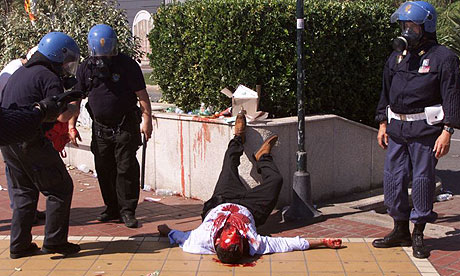
Riot cops surround a seriously injured anti-globalisation protester lying
on a pavement in central Genoa
It was just before midnight when the first police officer hit Mark Covell, swiping his truncheon down on his left shoulder. Covell did his best to yell out in Italian that he was a journalist but, within seconds, he was surrounded by riot-squad officers thrashing him with their sticks. For a while, he managed to stay on his feet but then a baton blow to the knee sent him crashing to the pavement.
Lying on his face in the dark, bruised and scared, he was aware of police all around him, massing to attack the Diaz Pertini school building where 93 young demonstrators were bedding down on the floor for the night. Covell's best hope was that they would break through the chain around the front gates without paying him any more attention. If that happened, he could get up and limp across the street to the safety of the Indymedia centre, where he had spent the past three days filing reports on the G8 summit and on its violent policing.
It was at that moment that a police officer sauntered over to him and kicked him in the chest with such force that the entire lefthand side of his rib cage caved in, breaking half-a-dozen ribs whose splintered ends then shredded the membrane of his left lung. Covell, who is 5ft 8in and weighs less than eight stone, was lifted off the pavement and sent flying into the street. He heard the policeman laugh. The thought formed in Covell's mind: "I'm not going to make it."
The riot squad were still struggling with the gate, so a group of officers occupied the time by strolling over to use Covell as a football. This bout of kicking broke his left hand and damaged his spine. From somewhere behind him, Covell heard an officer shout that this was enough - "Basta! Basta!" - and he felt his body being dragged back on to the pavement.
Now, an armoured police van broke through the school gates and 150 police officers, most wearing crash helmets and carrying truncheons and shields, poured into the defenceless building. Two officers stopped to deal with Covell: one cracked him round the head with his baton; the other kicked him several times in the mouth, knocking out a dozen teeth. Covell passed out.
There are several good reasons why we should not forget what happened to Covell, then aged 33, that night in Genoa. The first is that he was only the beginning. By midnight on July 21 2001, those police officers were swarming through all four floors of the Diaz Pertini building, dispensing their special kind of discipline to its occupants, reducing the makeshift dormitories to what one officer later described as "a Mexican butcher's shop". They and their colleagues then illegally incarcerated their victims in a detention centre, which became a place of dark terror.
The second is that, seven years later, Covell and his fellow victims are still waiting for justice. On Monday, 15 police, prison guards and prison medics finally were convicted for their part in the violence - although it emerged yesterday that none of them would actually serve prison terms. In Italy, defendants don't go to jail until they have exhausted the appeals process; and in this case, the convictions and sentences will be wiped out by a statute of limitations next year. Meanwhile, the politicians who were responsible for the police, prison guards and prison medics have never had to explain themselves. Fundamental questions about why this happened remain unanswered - and they hint at the third and most important reason for remembering Genoa. This is not simply the story of law officers running riot, but of something uglier and more worrying beneath the surface.
The fact that this story can be told at all is testament to seven years of hard work, led by a dedicated and courageous public prosecutor, Emilio Zucca. Helped by Covell as well as his own staff, Zucca has gathered hundreds of witness statements and analysed 5,000 hours of video as well as thousands of photographs. Pieced together, they tell an irrefutable tale, which began to unfold as Covell lay bleeding on the ground.
The police poured into the Diaz Pertini school. Some of them were shouting "Black Bloc! We're going to kill you," but if they genuinely believed they were confronting the notorious Black Bloc of anarchists who had caused violent mayhem in parts of the city during demonstrations earlier in the day, they were mistaken. The school had been provided by the Genoa city council as a base for demonstrators who had nothing to do with the anarchists: they had even posted guards to make sure that none of them came in.
One of the first to see the riot squad bursting in was Michael Gieser, a 35-year-old Belgian economist, who subsequently described how he had just changed into his pyjamas and was queuing for the bathroom with his toothbrush in his hand when the raid began. Gieser believes in the power of dialogue and, at first, he walked towards them saying, "We need to talk." He saw the padded jackets, the riot clubs, the helmets and the bandanas concealing the policemen's faces, changed his mind and ran up the stairs to escape.
Others were slower. They were still in their sleeping bags. A group of 10 Spanish friends in the middle of the hall woke up to find themselves being battered with truncheons. They raised their hands in surrender. More officers piled in to beat their heads, cutting and bruising and breaking limbs, including the arm of a 65-year-old woman. At the side of the room, several young people were sitting at computers, sending emails home. One of them was Melanie Jonasch, a 28-year-old archaeology student from Berlin, who had volunteered to help out in the building and had not even been on a demonstration.
She still cannot remember what happened. But numerous other witnesses have described how officers set upon her, beating her head so hard with their sticks that she rapidly lost consciousness. When she fell to the ground, officers circled her, beating and kicking her limp body, banging her head against a near-by cupboard, leaving her finally in a pool of blood. Katherina Ottoway, who saw this happen, recalled: "She was trembling all over. Her eyes were open but upturned. I thought she was dying, that she could not survive this."
None of those who stayed on the ground floor escaped injury. As Zucca later put it in his prosecution report: "In the space of a few minutes, all the occupants on the ground floor had been reduced to complete helplessness, the groans of the wounded mingling with the sound of calls for an ambulance." In their fear, some victims lost control of their bowels. Then the officers of the law moved up the stairs. In the first-floor corridor they found a small group, including Gieser, still clutching his toothbrush: "Someone suggested lying down, to show there was no resistance. So I did. The police arrived and began beating us, one by one. I protected my head with my hands. I thought, 'I must survive.' People were shouting, 'Please stop.' I said the same thing ... It made me think of a pork butchery. We were being treated like animals, like pigs."
Officers broke down doors to the rooms leading off the corridors. In one, they found Dan McQuillan and Norman Blair, who had flown in from Stansted to show their support for, as McQuillan put it, "a free and equal society with people living in harmony with each other". The two Englishmen and their friend from New Zealand, Sam Buchanan, had heard the police attack on the ground floor and had tried to hide their bags and themselves under some tables in the corner of the dark room. A dozen officers broke in, caught them in a spotlight and, even as McQuillan stood up with his hands raised saying, "Take it easy, take it easy," they battered them into submission, inflicting numerous cuts and bruises and breaking McQuillan's wrist. Norman Blair recalled: "I could feel the venom and hatred from them."
Gieser was out in the corridor: "The scene around me was covered in blood, everywhere. A policeman shouted 'Basta!'. This word was like a window of hope. I understood it meant 'enough'. And yet they didn't stop. They continued with pleasure. In the end, they did stop, but it was like taking a toy away from a child, against their will."
By now, there were police officers on all four floors of the building, kicking and battering. Several victims describe a sort of system to the violence, with each officer beating each person he came across, then moving on to the next victim while his colleague moved up to continue beating the first. It seemed important that everybody must be hurt. Nicola Doherty, 26, a care worker from London, later described how her partner, Richard Moth, lay across her to protect her: "I could just hear blow after blow on his body. The police were also leaning over Rich so they could hit the parts of my body which were exposed." She tried to cover her head with her arm: they broke her wrist.
In one corridor, they ordered a group of young men and women to kneel, the easier to batter them around the head and shoulders. This was where Daniel Albrecht, a 21-year-old cello student from Berlin, had his head beaten so badly that he needed surgery to stop bleeding in his brain. Around the building, officers flipped their batons around, gripping the far end and using the right-angled handle as a hammer.
And in among this relentless violence, there were moments when the police preferred humiliation: the officer who stood spread-legged in front of a kneeling and injured woman, grabbed his groin and thrust it into her face before turning to do the same to Daniel Albrecht kneeling beside her; the officer who paused amid the beatings and took a knife to cut off hair from his victims, including Nicola Doherty; the constant shouting of insults; the officer who asked a group if they were OK and who reacted to the one who said "No" by handing out an extra beating.
A few escaped, at least for a while. Karl Boro made it up on to the roof but then made the mistake of coming back into the building, where he was treated to heavy bruising to his arms and legs, a fractured skull, and bleeding in his chest cavity. Jaraslaw Engel, from Poland, managed to use builders' scaffolding to get out of the school, but he was caught in the street by some police drivers who smashed him over the head, laid him on the ground and stood over him smoking while his blood ran out across the Tarmac.
Two of the last to be caught were a pair of German students, Lena Zuhlke, 24, and her partner Niels Martensen. They had hidden in a cleaners' cupboard on the top floor. They heard the police approaching, drumming their batons against the walls of the stairs. The cupboard door came open, Martensen was dragged out and beaten by a dozen officers standing in a semicircle around him. Zuhlke ran across the corridor and hid in the loo. Police officers saw her and followed her and dragged her out by her dreadlocks.
In the corridor, they set about her like dogs on a rabbit. She was beaten around the head then kicked from all sides on the floor, where she felt her rib cage collapsing. She was hauled up against the wall where one officer kneed her in the groin while others carried on lashing her with their batons. She slid down the wall and they hit her more on the ground: "They seemed to be enjoying themselves and, when I cried out in pain, it seemed to give them even more pleasure."
Police officers found a fire extinguisher and squirted its foam into Martensen's wounds. His partner was dragged by her hair and tossed down the stairs head-first. Eventually, they dragged Zuhlke into the ground-floor hall, where they had gathered dozens of prisoners from all over the building in a mess of blood and excrement. They threw her on top of two other people. They were not moving, and Zuhlke drowsily asked them if they were alive. They did not reply, and she lay there on her back, unable to move her right arm, unable to stop her left arm and her legs twitching, blood seeping out of her head wounds. A group of police officers walked by, and each one lifted the bandana which concealed his identity, leaned down and spat on her face.
Why would law officers behave with such contempt for the law? The simple answer may be the one which was soon being chanted outside the school building by sympathetic demonstrators who chose a word which they knew the police would understand: "Bastardi! Bastardi!" But something else was happening here - something that emerged more clearly over the next few days.
Covell and dozens of other victims of the raid were taken to the San Martino hospital, where police officers walked up and down the corridors, slapping their clubs into the palms of their hands, ordering the injured not to move around or look out of the window, keeping handcuffs on many of them and then, often with injuries still untended, shipping them across the city to join scores of others, from the Diaz school and from the street demonstrations, detained at the detention centre in the city's Bolzaneto district.
The signs of something uglier here were apparent first in superficial ways. Some officers had traditional fascist songs as ringtones on their mobile phones and talked enthusiastically about Mussolini and Pinochet. Repeatedly, they ordered prisoners to say "Viva il duce." Sometimes, they used threats to force them to sing fascist songs: "Un, due, tre. Viva Pinochet!"
The 222 people who were held at Bolzaneto were treated to a regime later described by public prosecutors as torture. On arrival, they were marked with felt-tip crosses on each cheek, and many were forced to walk between two parallel lines of officers who kicked and beat them. Most were herded into large cells, holding up to 30 people. Here, they were forced to stand for long periods, facing the wall with their hands up high and their legs spread. Those who failed to hold the position were shouted at, slapped and beaten. Mohammed Tabach has an artificial leg and, unable to hold the stress position, collapsed and was rewarded with two bursts of pepper spray in his face and, later, a particularly savage beating. Norman Blair later recalled standing like this and a guard asking him "Who is your government?" "The person before me had answered 'Polizei', so I said the same. I was afraid of being beaten."
Stefan Bauer dared to answer back: when a German-speaking guard asked where he was from, he said he was from the European Union and he had the right to go where he wanted. He was hauled out, beaten, given a face full of pepper spray, stripped naked and put under a cold shower. His clothes were taken away and he was returned to the freezing cell wearing only a flimsy hospital gown.
Shivering on the cold marble floors of the cells, the detainees were given few or no blankets, kept awake by guards, given little or no food and denied their statutory right to make phone calls and see a lawyer. They could hear crying and screaming from other cells.
Men and women with dreadlocks had their hair roughly cut off to the scalp. Marco Bistacchia was taken to an office, stripped naked, made to get down on all fours and told to bark like a dog and to shout "Viva la polizia Italiana!" He was sobbing too much to obey. An unnamed officer told the Italian newspaper La Repubblica that he had seen brother officers urinating on prisoners and beating them for refusing to sing Faccetta Nera, a Mussolini-era fascist song.
Ester Percivati, a young Turkish woman, recalled guards calling her a whore as she was marched to the toilet, where a woman officer forced her head down into the bowl and a male jeered "Nice arse! Would you like a truncheon up it?" Several women reported threats of rape, anal and vaginal.
Even the infirmary was dangerous. Richard Moth, covered in cuts and bruises after lying on top of his partner, was given stitches in his head and legs without anaesthetic - "an extremely painful and disturbing experience. I had to be held down." Prison medical staff were among those convicted of abuse on Monday.
All agree that this was not an attempt to get the detainees to talk, simply an exercise in creating fear. And it worked. In statements, prisoners later described their feeling of helplessness, of being cut off from the rest of the world in a place where there was no law and no rules. Indeed, the police forced their captives to sign statements, waiving all their legal rights. One man, David Larroquelle, testified that he refused and had three of his ribs broken. Percivati also refused and her face was slammed into the office wall, breaking her glasses and making her nose bleed.
The outside world was treated to some severely distorted accounts of all this. Lying in San Martino hospital the day after his beating, Covell came round to find his shoulder being shaken by a woman who, he understood, was from the British embassy. It was only when the man with her started taking photographs that he realised she was a reporter, from the Daily Mail. Its front page the next day ran an entirely false report describing him as having helped mastermind the riots. (Four long years later, the Mail eventually apologised and paid Covell damages for invasion of privacy.)
While his citizens were being beaten and tormented in illegal detention, spokesmen for the then prime minister, Tony Blair, declared: "The Italian police had a difficult job to do. The prime minister believes that they did that job."
The Italian police themselves fed the media with a rich diet of falsehood. Even as the bloody bodies were being carried out of the Diaz Pertini building on stretchers, police were telling reporters that the ambulances lined up in the street were nothing to do with the raid, and/or that the very obviously fresh injuries were old, and that the building had been full of violent extremists who had attacked officers.
The next day, senior officers held a press conference at which they announced that everybody in the building would be charged with aggressive resistance to arrest and conspiracy to cause destruction. In the event, the Italian courts dismissed every single attempted charge against every single person. That included Covell. Police attempts to charge him with a string of very serious offences were described by the public prosecutor, Enrico Zucca, as "grotesque".
At the same press conference, police displayed an array of what they described as weaponry. This included crowbars, hammers and nails which they themselves had taken from a builder's store next to the school; aluminium rucksack frames, which they presented as offensive weapons; 17 cameras; 13 pairs of swimming goggles; 10 pen-knives; and a bottle of sun-tan lotion. They also displayed two Molotov cocktails which, Zucca later concluded, had been found by police earlier in the day in another part of the city and planted in the Diaz Pertini building as the raid ended.
This public dishonesty was part of a wider effort to cover up what had happened. On the night of the raid, a force of 59 police entered the building opposite the Diaz Pertini, where Covell and others had been running their Indymedia centre and where, crucially, a group of lawyers had been based, gathering evidence about police attacks on the earlier demonstrations. Officers went into the lawyers' room, threatened the occupants, smashed their computers and seized hard drives. They also removed anything containing photographs or video tape.
With the courts refusing to charge the detainees, the police secured an order to deport all of them from the country, banning them from returning for five years. Thus, the witnesses were removed from the scene. Like the attempted charges, all the deportation orders were subsequently dismissed as illegal by the courts.
Zucca then fought his way through years of denial and obfuscation. In his formal report, he recorded that all the senior officers involved were denying playing any part: "Not a single official has confessed to holding a substantial command role in any aspects of the operation." One senior officer who was videoed at the scene explained that he was off duty and had just turned up to make sure his men were not being injured. Police statements were themselves changeable and contradictory, and were overwhelmingly contradicted by the evidence of victims and numerous videos: "Not a single one of the 150 officers reportedly present has provided precise information regarding an individual episode."
Without Zucca, without the robust stance of the Italian courts, without Covell's intensive work assembling video records of the Diaz raid, the police might well have evaded responsibility and secured false charges and prison sentences against scores of their victims. Apart from the Bolzaneto trial which finished on Monday, 28 other officers, some very senior, are on trial for their part in the Diaz raid. And yet, justice has been compromised.
No Italian politician has been brought to book, in spite of the strong suggestion that the police acted as though somebody had promised them impunity. One minister visited Bolzaneto while the detainees were being mistreated and apparently saw nothing or, at least, saw nothing he thought he should stop. Another, Gianfranco Fini, former national secretary of the neo-fascist MSI party and the then deputy prime minister, was - according to media reports at the time - in police headquarters. He has never been required to explain what orders he gave.
Most of the several hundred law officers involved in Diaz and Bolzaneto have escaped without any discipline or criminal charge. None has been suspended; some have been promoted. None of the officers who were tried over Bolzaneto has been charged with torture - Italian law does not recognise the offence. Some senior officers who were originally going to be charged over the Diaz raid escaped trial because Zucca was simply unable to prove that a chain of command existed. Even now, the trial of the 28 officers who have been charged is in jeopardy because the prime minister, Silvio Berlusconi, is pushing through legislation to delay all trials dealing with events that occurred before June 2002. Nobody has been charged with the violence inflicted on Covell. And as one of the victims' lawyers, Massimo Pastore, put it: "Nobody wants to listen to what this story has to say."
That is about fascism. There are plenty of rumours that the police and carabinieri and prison staff belonged to fascist groups, but no evidence to support that. Pastore argues that that misses the bigger point: "It is not just a matter of a few drunken fascists. This is mass behaviour by the police. No one said 'No.' This is a culture of fascism." At its heart, this involved what Zucca described in his report as "a situation in which every rule of law appears to have been suspended."
Fifty-two days after the attack on the Diaz school, 19 men used planes full of passengers as flying bombs and shifted the bedrock of assumptions on which western democracies had based their business. Since then, politicians who would never describe themselves as fascists have allowed the mass tapping of telephones and monitoring of emails, detention without trial, systematic torture, the calibrated drowning of detainees, unlimited house arrest and the targeted killing of suspects, while the procedure of extradition has been replaced by "extraordinary rendition". This isn't fascism with jack-booted dictators with foam on their lips. It's the pragmatism of nicely turned-out politicians. But the result looks very similar. Genoa tells us that when the state feels threatened, the rule of law can be suspended. Anywhere.
http://www.guardian.co.uk/world/2008/jul/17/italy.g8
* Genoa riots: 15 guilty of G8 brutality will not go to jail
Somehow(^^) related:


Already last week (7.08) BWI initiated an on-line Solidarity Campaign for S. Korea:
Support the Branch of the Pohang Construction Plant Workers Union!
Take two minutes to sign our solidarity campaign to support the Branch of the Pohang Construction Plant Workers Union, KFCITU in South Korea.
POSCO, a major steel production company in the country, launched a systematic campaign to break the union since the strike in 2006 by forcing union members to quit if they want to work and limiting access of union officials entering sites to address members issues. Members are still in jail.
We cannot tolerate that POSCO has used its political and economic clout in Pohang, where the company controls at least 70% of the economy to implement a deliberate and strategic plan to break the union through various tactics.
We call upon you to participate and forward this message to your fellow union members and co-workers. It is very important that you involve people in your union, in your workplace, who haven't yet had the satisfaction of sending off a message...
The full text of the Soli Campaign you can (MUST!!) read and sign here:
http://www.bwint.org/default.asp?Index=1788&Language=EN
Related/background:
☞ Korea: Anti-union repression continues (ITUC, 7.17)
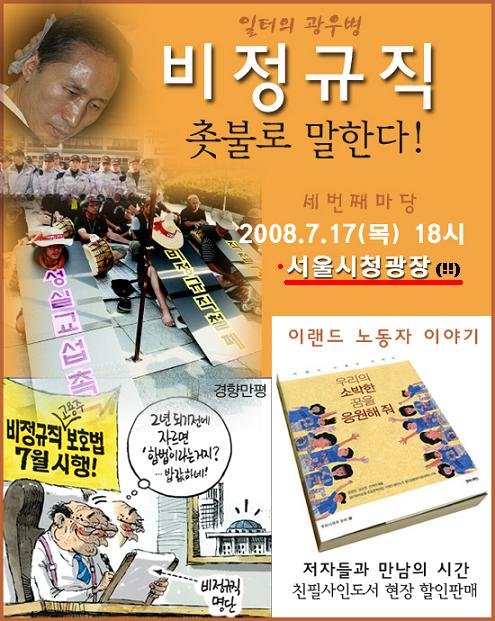
BTW.. it would be very pleasant to hear on tomorrow's anti-gov't protests NOTHING about the f.. Dok-do issue, because there are (likely^^) many more important disgraces to protest/fight against! For example the massive exploitation of millions of "irregular" workers, the situation of migrant workers (i.e. the ongoing crackdown and the oppression of MTU!), the f... education system, the idiotic N"S"L, the presence of USFK, but also the nationalism in parts of the "progressive" movement etc. etc...
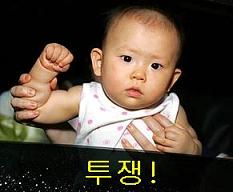
It's now almost 7 years ago that the Italian gov't tryed to supress the/all protests against the 2001-G8 summit in Genoa with a wave of massive state terror. "Death and terror in Genoa" - like that observers described the time in July 2001 there.
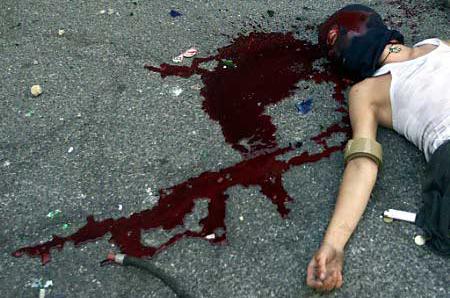
The Italian anarchist C. Guliani, killed 2001.7.20 by the police during a demonstration
Yesterday, after years of delay, a few state servants who realized the policy of state terror by committing crimes against the human/civil rights of hundreds of protesters, were sentenced.., as the Guardian (UK) reported today:
Rape threats, beatings and racist chants: 15 Italians jailed for abuse of G8 Genoa protesters
Fifteen Italian police officers and doctors were last night sentenced to jail terms of up to five years after being found guilty of abusing protesters detained during riots at the 2001 G8 summit in Genoa.
Thirty other defendants were cleared of charges ranging from assault to the denial of basic human rights. The judges issued their verdicts after 11 hours of closed-doors deliberations.
The sentences totalled less than a third of what had been demanded by the prosecution. But they will nevertheless be embarrassing for Silvio Berlusconi and his rightwing allies, in office in Italy both then and now.
The court heard former detainees including Britons testify that they were insulted, beaten and sprayed with asphyxiating gas. Some were threatened with rape.
Detainees were made to join in chants in praise of Italy's late fascist dictator, Benito Mussolini. Another chant, lauding Chile's Augusto Pinochet, ended: "Death to the Jews."
Between 100,000 and 200,000 demonstrators converged on Genoa seven years ago to take part in anti-globalisation protests. Most were peaceable, but some were not, and the situation deteriorated as the police employed tactics that many witnesses described as heavy-handed.
The violence peaked with the death of a 23-year-old Italian demonstrator, shot dead by a conscript Carabiniere. More than 250 of those arrested were taken to a holding camp that had been created at Bolzaneto, six miles from Genoa, where the abuses took place.
The heaviest sentence, five years, was given to the camp commander, Antonio Biagio Gugliotta. Twelve other police officers, eight men and four women, received jail terms of five to 28 months.
The chief of medical services at Bolzaneto, Giacomo Toccafondi, was given one year and two months in jail; he was accused of insulting detainees and failing to inform authorities after they were sprayed with asphyxiating gas in cells.
The detainees at Bolzaneto included about 40 who were arrested in a raid on a school being used as a dormitory. A judge ruled that there was no evidence to show any of those demonstrators had been involved in the violence in Genoa.
One, a Briton, Richard Moth, later told the Guardian that, despite injuries sustained in the raid that had him "screaming with pain", he was made to stand for hours spread-eagled against a wall.
The Bolzaneto trial was one of three arising from the Genoa G8 summit. In December 2007, 24 demonstrators were found guilty of damage to property and looting. They were given sentences ranging from five months to 11 years. In the third, ongoing trial, 28 defendants, including some of Italy's most senior police officers, face charges related to the raid on the school, which left 62 injured, three in comas.
http://www.guardian.co.uk/world/2008/jul/15/italy.g8
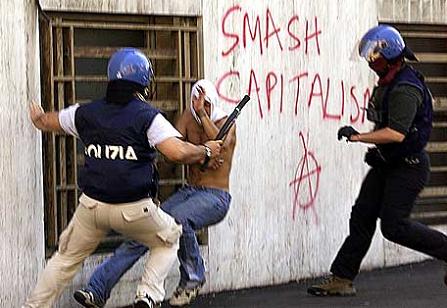
An expression of another opinion.. led to a "special treatment" by the Italian riot cops!
Related reports/articles (July 2001):
☞ The Horrific Torture of Genoa Protesters
☞ Gipfelstuermer - The Bloody Days of Genoa
N.K.'s "news"agency KCNA today ("only" three days after the deadly "incident" took place!!) published the first official statement (*).
But while the main parts of the statement are already internationally well-known (especially the obscure demand that "The south side should be held responsible for the incident, make clear apology to the north side.."^^), the text reports also about a typical miracle "Made in D.P.R.K."! While almost everyone knows that the victim, Park Wang-ja, was a middle-aged housewife from Seoul, her death in the "Paradise of the Korean Nation" changed surprisingly her gender!
But possibly it's just the result of the mad ideas of KCNA's editors and/or the Dear Leader's "ingenious wisdom"! Because: likely (??) they're just thinking that the murder of a male person is more tolerably/less disgusting for the int'l public..
* South Side Chiefly to Blame for Incident at Mt. Kumgang Resort
A south Korean who came to tour Mt. Kumgang was shot to death by a serviceman of the Korean People's Army at around 4:50 a.m. on July 11. A spokesman for the Guidance Bureau for Comprehensive Development of Scenic Spots issued a statement on Saturday in this regard.
The DPRK feels regretful at this, the statement notes, and goes on:
As for the cause of the incident, it occurred because the south Korean tourist trespassed on the area under the military control of the north side, going beyond the tourist zone.
A particular mention should be made of the fact that the south Korean tourist intruded deep into the area under the military control of the north side all alone at dawn, going beyond the clearly marked boundary fence, even his shoes got wet.
When a KPA serviceman spotted him and ordered him to stop, he did not obey the order but began to run away. He kept running although the KPA serviceman repeatedly shouted at him to stop, even firing blank bullets. The KPA serviceman could not but open fire at him.
The responsibility for the incident entirely rests with the south side.
The south side should be held responsible for the incident, make clear apology to the north side and take measures against the recurrence of the similar incident.
Nevertheless, the south side authorities unilaterally announced that they would suspend the tour of Mt. Kumgang for the time being, a challenge to the north side.
As it is an intolerable insult to the north side, it will take a measure not to accept south Korean tourists until the south side makes proper apology for the recent incident and takes measures against the recurrence of such incident.
As the cause of the incident is very clear and the north side has already confirmed the scene of the incident together with personnel of the Hyundai side right after its occurrence, it cannot accept the south side's proposal for inspecting the area of the north side for investigation.
http://www.kcna.co.jp/item/2008/200807/news07/14.htm#1
최근 덧글 목록